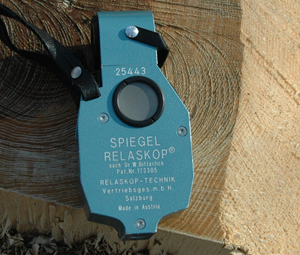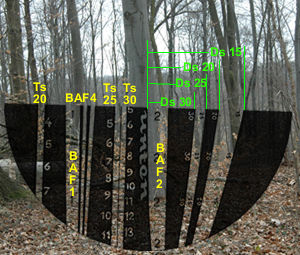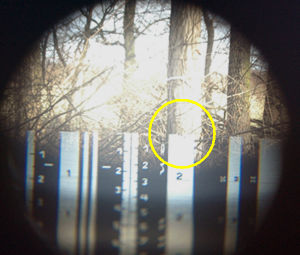Relascope
| (10 intermediate revisions by 2 users not shown) | |||
| Line 1: | Line 1: | ||
| + | {{Ficontent}} | ||
==General description== | ==General description== | ||
| − | + | The Bitterlich relascope (Austrian designer [http://de.wikipedia.org/wiki/Walter_Bitterlich Walter Bitterlich]) is a multifunctional device that can be used to make an [[Bitterlich sampling|angle count sample]] to estimate [[basal area]] depending on [[Bitterlich_sampling#Choice_of_basal_area_factor|basal area factor]]. Additionally it can be used for height measurements by [[the trigonometric principle]] and to measure [[Measurement with the relascope|upper diameters]] in different heights to estimate form heights, form numbers and scape volumes for trees. | |
| − | The Bitterlich relascope (Austrian designer [http://de.wikipedia.org/wiki/Walter_Bitterlich Walter Bitterlich]) is a multifunctional device that can be used to make an [[Bitterlich sampling|angle count sample]] to estimate [[basal area]] depending on [[Bitterlich_sampling#Choice_of_basal_area_factor|basal area factor]]. Additionally it can be used for height measurements by [[the trigonometric principle]] and to measure | + | |
The relascope is constructed with a cylinder pendulum which enables automatic [[Fixed_area_plots#Slope_correction|slope correction]] for each estimate. Therefore you will have to press the button at the front of the device till the pendel stops moving (to be sure, that the slope is included) – disengage the button to lock the scales. The visual appearance while looking through the relascope is constructed as a horizontal sighting which appears in the half of the view. | The relascope is constructed with a cylinder pendulum which enables automatic [[Fixed_area_plots#Slope_correction|slope correction]] for each estimate. Therefore you will have to press the button at the front of the device till the pendel stops moving (to be sure, that the slope is included) – disengage the button to lock the scales. The visual appearance while looking through the relascope is constructed as a horizontal sighting which appears in the half of the view. | ||
| Line 8: | Line 8: | ||
If the light is too bright, you can darken the scales by moving up a small bar, which is assembled at the front of the device. | If the light is too bright, you can darken the scales by moving up a small bar, which is assembled at the front of the device. | ||
| − | |||
| − | |||
The following table gives a short description of the different scales implemented in the relascope. | The following table gives a short description of the different scales implemented in the relascope. | ||
| Line 48: | Line 46: | ||
|distance scale for a 2m vertical base to measure horizontal distance of 15m | |distance scale for a 2m vertical base to measure horizontal distance of 15m | ||
|} | |} | ||
| + | |||
==Handling== | ==Handling== | ||
| − | To do an [[Bitterlich sampling|angle count]] look through the device and press the lock button so that pendulum can work to do automatically a slope correction. For a detailed description of the different scales and handling please see the manual. | + | To do an [[Bitterlich sampling|angle count]] look through the device and press the lock button so that pendulum can work to do automatically a slope correction. Choose a basal area factor and count all trees that appear bigger than the respective scale in a 360° turn. An estimate of basal area (m²/ha) can be calculated by multiplying the counted number with the basal area factor (for theory see [[Bitterlich sampling]]). |
| + | |||
| + | For a detailed description of the different scales and handling please see the manual. | ||
Below a few case examples are given doing an angle count sample. | Below a few case examples are given doing an angle count sample. | ||
| Line 60: | Line 61: | ||
|- | |- | ||
|multifunctional device – parameters to describe the form single trees and also forest stand parameters can be derived | |multifunctional device – parameters to describe the form single trees and also forest stand parameters can be derived | ||
| − | | | + | |in dark forest stand optical measurement is difficult, no digital storage of measurement results available. |
|- | |- | ||
|slope correction implemented | |slope correction implemented | ||
| Line 66: | Line 67: | ||
|- | |- | ||
|independence of power sources (no batteries needed) | |independence of power sources (no batteries needed) | ||
| − | | | + | | |
|} | |} | ||
To measure large tree diameters in different heights, Bitterlich has developed a relascope with another broad scale view. <br> Here a scale is implemented to measure slope in degrees and percentage, and scales for basal area factors up to 11. | To measure large tree diameters in different heights, Bitterlich has developed a relascope with another broad scale view. <br> Here a scale is implemented to measure slope in degrees and percentage, and scales for basal area factors up to 11. | ||
| Line 75: | Line 76: | ||
</gallery> | </gallery> | ||
| − | + | ==See also== | |
| + | [//www.relaskop.at/ RELASKOP-TECHNIK Vertriebsges.m.b.H.http] | ||
| + | |||
| + | [https://www.youtube.com/watch?v=aPvhW24BL8o Video on the principle of relascope sampling] | ||
| + | |||
| + | ==Manuals== | ||
| + | |||
| + | [[:File:Spiegel-Relaskop Deutsch 1.Teil.pdf|Mirror Relascope part 1 German]] | ||
| + | |||
| + | [[:File:Spiegel-Relaskop_English_Metric_and_Metric_CP.pdf|Mirror Relascope part 1 English]] | ||
| + | |||
| + | [[:File:Spiegel_Relaskop_2._Teil_Deutsch_und_English.pdf|Mirror Relascope part 2 Engish + German]] | ||
| + | |||
==Applications== | ==Applications== | ||
* [[Bitterlich sampling]] | * [[Bitterlich sampling]] | ||
* [[Bitterlich sampling|Angle count sampling]] | * [[Bitterlich sampling|Angle count sampling]] | ||
* [[The trigonometric principle|Height measurement]] | * [[The trigonometric principle|Height measurement]] | ||
| − | * [[ | + | * [[Measurement with the relascope|Upper diameters]] |
==Related articles== | ==Related articles== | ||
| Line 86: | Line 99: | ||
* [[Bitterlich sampling]] | * [[Bitterlich sampling]] | ||
| − | + | {{Studienbeiträge}} | |
[[Category: Measurement devices]] | [[Category: Measurement devices]] | ||
| + | [[Category: Clinometer]] | ||
Latest revision as of 12:51, 19 June 2015
Contents |
[edit] General description
The Bitterlich relascope (Austrian designer Walter Bitterlich) is a multifunctional device that can be used to make an angle count sample to estimate basal area depending on basal area factor. Additionally it can be used for height measurements by the trigonometric principle and to measure upper diameters in different heights to estimate form heights, form numbers and scape volumes for trees.
The relascope is constructed with a cylinder pendulum which enables automatic slope correction for each estimate. Therefore you will have to press the button at the front of the device till the pendel stops moving (to be sure, that the slope is included) – disengage the button to lock the scales. The visual appearance while looking through the relascope is constructed as a horizontal sighting which appears in the half of the view.
If the light is too bright, you can darken the scales by moving up a small bar, which is assembled at the front of the device.
The following table gives a short description of the different scales implemented in the relascope.
| Scale name | description |
|---|---|
| Ts 20 (Tangent scale) | height measurement for distance 20m |
| BAF 1 (basal area factor 1) | angel count method for basal area factor =1 |
| BAF 4 (basal area factor 4) | angel count method for basal area factor =4 (BAF 1 combined with the following 4 relascope units) |
| Ts 25 (Tangent scale) | height measurement for distance 25m |
| Ts 30 (Tangent scale) | height measurement for distance 30m |
| BAF 2 (basal area factor 2) | angel count method for basal area factor =2 |
| Ds 30 | distance scale for a 2m vertical base to measure horizontal distance of 30m |
| Ds 25 | distance scale for a 2m vertical base to measure horizontal distance of 25m |
| Ds 20 | distance scale for a 2m vertical base to measure horizontal distance of 20m |
| Ds 15 | distance scale for a 2m vertical base to measure horizontal distance of 15m |
[edit] Handling
To do an angle count look through the device and press the lock button so that pendulum can work to do automatically a slope correction. Choose a basal area factor and count all trees that appear bigger than the respective scale in a 360° turn. An estimate of basal area (m²/ha) can be calculated by multiplying the counted number with the basal area factor (for theory see Bitterlich sampling).
For a detailed description of the different scales and handling please see the manual. Below a few case examples are given doing an angle count sample.
| Advantages | Disadvantages |
|---|---|
| multifunctional device – parameters to describe the form single trees and also forest stand parameters can be derived | in dark forest stand optical measurement is difficult, no digital storage of measurement results available. |
| slope correction implemented | |
| independence of power sources (no batteries needed) |
To measure large tree diameters in different heights, Bitterlich has developed a relascope with another broad scale view.
Here a scale is implemented to measure slope in degrees and percentage, and scales for basal area factors up to 11.
[edit] See also
RELASKOP-TECHNIK Vertriebsges.m.b.H.http
Video on the principle of relascope sampling
[edit] Manuals
Mirror Relascope part 1 German
Mirror Relascope part 1 English
Mirror Relascope part 2 Engish + German




